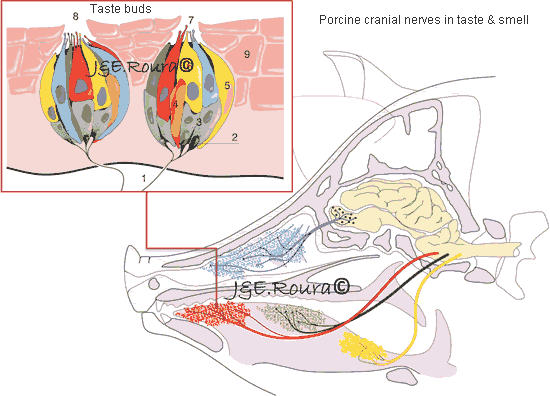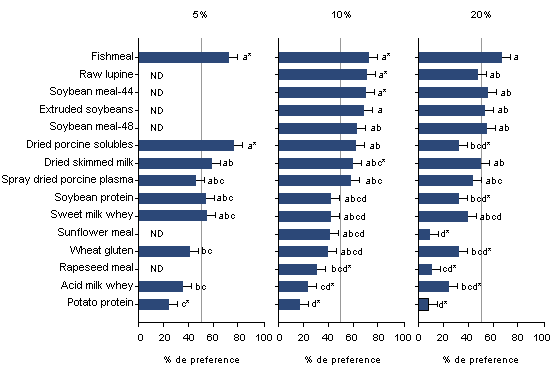Sweet and umami tastes: who is what?
Taste and smell are two of the peripheral sensing mechanisms devoted to food identification. The taste system senses the nutritional value of foods through the taste buds defined as clusters of taste sensory cells present in the tongue (figure 1). As discussed in Part I (The good taste of pigs (part I): let it be sweet) simple carbohydrates stimulate sweet taste in pigs. However, high intensity sweeteners known to humans and that are commonly used in piglet diets (Sodium Saccharin, Thaumatin and Neohespiridine dehydrocalcone) they only trigger minor sweet taste responses in pigs tongue and do not seem to be effective in increasing feed intake but they may play a key role in carbohydrate digestion/absorption by stimulating the sweet taste receptors (TR) present in the gastrointestinal tract (GIT).
Figure 1. The smell and taste system in the pig: cranial nerves and a detail of the taste buds.

In humans sweet perception has become a paradigm of “good taste” easy to sense and identify. Similar to sweet, the umami taste also enhances voluntary intake in mammals. Several L-amino acids (L-AA), such as Glutamic acid (L-Glu) or monosodium glutamate (MSG), trigger umami taste. Umami remains largely as an unknown taste modality to the general public likely because it may not be easy to distinguish from other tastes (i.e. salty) or flavours (meaty). However, humans have a detection threshold for MSG that is around 10 fold lower than for sugar (around 1mM and 10 mM respectively). The detection thresholds for MSG and sugar in pigs are very similar to humans (around 1mM and between 5 to 10 mM respectively). Furthermore pigs show a positive preference not only to MSG (and L-Glu) but also to other amino acids not perceived as umami by humans such as glutamine, alanine and asparagine among others (table 1). These findings may indicate that mammals have a higher acuity of taste in detecting amino acids than sugars and a potential higher craving for dietary protein compared to carbohydrates.
Table 1. Gustatory responsiveness of pigs to L-amino acids and predominant hedonic response in humans.

| Amino Acid | L-isomer | |
| Human taste | Pig response(1) | |
|
Alanine |
Sweet | Umami |
|
Arginine |
Bitter | Umami |
| Asparagine | Bitter | Umami |
| Aspartic a. | Umami, sour | Umami |
| Cysteine | Sulphur | n/a |
| Glutamic a. | Umami, salty | Umami |
| Glutamine | Sweet, umami | Umami |
| Glycine | Sweet | Yes |
| Histidine | Bitter | No |
| Hydroxyproline | Sweet | Yes |
| Isoleucine | Bitter | No |
| Leucine | Bitter | No |
| Lysine | Bitter, salty, sweet | Yes |
| Methionine | Bitter, Sulphur, umami | No |
| Phenylalanine | Bitter | No |
| Proline | Sweet, salty | Umami |
| Serine | Sweet | Yes |
|
Threonine |
Sweet | Umami |
|
Tryptophan |
Bitter | Bitter |
|
Tyrosine |
Bitter | n/a |
| Valine | Bitter | No |
(1)Pig response: n/a=not available; YES means that there is a response but the type of taste has not been identified; NO means no response.
(Adapted from Roura and Tedo. 2009. Feed appetence in pigs: an oronasal sensing perspective. In: D. Torrallardona and E. Roura Eds. Voluntary feed intake in pigs. Wageningen Academic Publishers, The Netherlands)
So, do pigs find proteins tastier than carbohydrates?
It is likely to be so. In our studies on piglet feed preferences (double choice tests), we have observed marked effects related to the nature of the ingredients. Test feed preference over a reference feed is expressed as a per cent consumption of the test feed over the total consumption (test + reference diets). A preference of 50% corresponds to a neutral value, that is when equal amounts of the two feeds presented were eaten. We have reported that changes in 1% of the inclusion rate of a test cereal result in increments (positive or negative) of preference compared to the neutral value of around 2%. A similar ratio is found for fibre sources (1% increase for 2% impact on preference value) and slightly lower value for fat sources (1% inclusion for around 1% changes in preference). Remarkably, in our studies, every 1% change in the inclusion of a test protein resulted in ca 5% increase or decrease in preference over the 50% neutral value. This data indicates that protein sources have the highest relative impact on feed preference among the families of feed ingredients that we tested (table 2). Furthermore it has been widely reported in the literature that most of the ingredients with the highest impact on feed preferences such as fish meal, whey protein concentrate, spray-dried animal plasma and dried porcine solubles, have the common feature of containing significant salty and umami taste compounds.
Table 2. Pig’s preference (% of total feed intake) for diets containing 5, 10 or 20% of different protein sources offered in a two-way choice with a common reference diet.

Columns with different letters indicate significantly different preference values (P<0.05).
* Indicate a preference value significantly different from 50% (P<0.05).
(Source: Torrallardona and Solà-Oriol. 2009. In: D. Torrallardona and E. Roura Eds. Voluntary Feed intake in Pigs. Wageningen Academic Publishers, The Netherlands).
Effects of protein on feed intake
The presence of umami receptors in the tongue contribute to the positive effect of some protein sources on feed preference and intake particularly in piglets. Under protein or general malnutrition (such as at weaning) these taste receptors are over-expressed as part of the response that increases the craving for protein rich diets. During these critical periods, therefore, stimulating the umami sensors will result in significant increases in feed intake. In other words, the use of highly palatable protein sources in early phases will result in increases of feed intake and growth rate post-weaning.
Umami taste receptors have also been found in the GIT mucosa sensing amino acids in the lumen gut. It is believed that they are involved in amino acid absorption and metabolism much to a similar fashion that sweet receptors affect simple carbohydrate metabolism. These intestinal nutrient sensing mechanisms are, in turn, linked to the controls of the hunger-satiety cycle. High preference proteins, therefore, are not only securing a short term feed intake but a long-term effect might be also explained through intestinal mechanisms. Finally, it is becoming clear that at the intestinal level carbohydrate and amino acid sensors (taste sensory cells) are integrated into a crosstalk cellular mechanism aimed at facilitating the indistinct use of the two dietary nutrient sources to meet the energy requirements. Additional research is required to verify the relevance of such findings in pigs and humans.
In summary
Pigs have high sensitivity for umami taste that is about 10 fold than of sweet taste. Data on dietary ingredient preferences confirm the craving of piglets for proteins. Nutritionists should pay attention to the preference rankings of proteins to anticipate increased feed acceptance by pigs at critical stages such as immediately after weaning or in feed transitions (particularly after drastic formulation changes). In addition, after such critical periods, the balance between umami (protein) and sweet (carbohydrate) sensing is the adequate strategy to target maximal long term feed intake.



